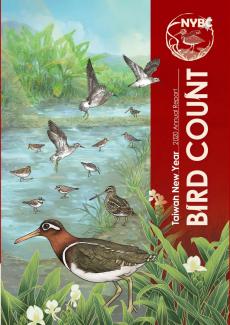
Preface & Acknowledgements
Da-Li Lin
The year 2020 was poised to be the super year of biodiversity conservation--serving as the final year for the Aichi Biodiversity Targets as well as seeing the conference of parties for both the Convention on Migratory Species and Convention on Biodiversity. However, due to the unprecedented challenges posed by the emergence of Covid-19 and the subsequent global lockdown, these important meetings were unable to take place and have been postponed until a better time could be found. Fortunately, for this year’s NYBC, the surveys were able to take place without issue. The organizers are therefore able to present an uninterrupted look at the situation facing migratory birds along the East Asian-Australasian Flyway in 2020.
The Taiwan New Year Bird Count (NYBC) is a citizen science project which aims to monitor the status and trends of migratory waterbirds in Taiwan proper and its outlying islands. This 7th report represents the results of the Taiwan NYBC 2020, conducted from December 21, 2019 to January 12, 2020. During this year’s survey, 1,054 participants recorded 323,979 bird individuals from 350 species in 176 circle samples.
Our survey results provide comprehensive insight into the distribution and community composition of the wintering avifauna of Taiwan. This has importance for conservation goals along the East Asian-Australasian Flyway as it offers an in depth look at the site usage of a number of migratory bird species. The data is also shared with Wetlands International for use in the Asian Waterbird Census. The organizers would like to express their deep gratitude and appreciation to all the participants, NGOs, donors, and sponsors without whom the Taiwan NYBC would not be possible.
The loss of wild lands over the last thirty years has served as one of the biggest factors behind global biodiversity loss. Once natural landscapes have been altered for purposes such as agriculture, grazing, or silviculture. Yet though their main function has become the production of goods for human consumption, it is hoped that newer forms of management along with conservation actions can allow for these areas to become more biodiversity-friendly. One main goal of the conservation movement should be to improve the functionality and capacity for biodiversity conservation in these altered landscapes.
Over the last two decades, The East Asian-Australasian Flyway (EAAF) has seen a dramatic decrease in the number of the migratory waterbirds which use it. One of the major factors contributing to this has been habitat disturbance, in the form of both loss and degradation. To emphasize the importance of creating more biodiversity-friendly agricultural lands, this year the organizers of NYBC 2020 chose as mascots migratory waterbirds which prefer paddy field ecosystems. There were five in total: Little Ringed Plover (Charadrius dubius), Wood Sandpiper (Tringa glareola), Common Snipe (Gallinago gallinago), Greater Painted-Snipe (Rostratula benghalensis), and Long-toed Stint (Calidris subminuta). Their status and trends serve, in a way, as a barometer for the health of these agricultural landscapes.
For our 2020 report, an analysis of NYBC data collected between 2014 and 2019 was also done to assess population trends for the 47 species of migratory waterbirds which can be found in Taiwan. The results were mixed. They showed that 15 species had experienced significant declines, especially in northeastern Taiwan. This number included all 2020 mascot species. Trends of decline were also noted for Eurasian Wigeon (Mareca penelope), Pacific Golden Plover (Pluvialis fulva), Lesser Sand Plover (Charadrius mongolus), Common Sandpiper (Actitis hypoleucos), Common Greenshank (Tringa nebularia) , Marsh Sandpiper (Tringa stagnatilis), Common Redshank (Tringa totanus), Ruddy Turnstone (Arenaria interpres) , Sanderling (Calidris alba), and Dunlin (Calidris alpina). These findings alert us to the need for more protection for these species and their habitats. The organizers also recognize that this data must be shared with the other countries along these species’ ranges. As birds don’t know borders, it is only through collective efforts that the conservation needs of migratory bird species can be properly addressed. Taiwan’s NYBC data provides a key piece to the puzzle of understanding the situation on the ground for migratory birds in East Asia and the EAAF. As members of the global community, Taiwan will continue to do its best to monitor, share information on, and conserve the migratory birds along this major flyway.
The Taiwan NYBC is organized by the Chinese Wild Bird Federation (CWBF), the Wild Bird Society of Taipei (WBST), the Kaohsiung Wild Bird Society (KWBS) and the Taiwan Endemic Species Research Institute (TESRI). They would also like to give special thanks to Allen Lyu (CWBF), Scott Pursner (CWBF), Kung-Kuo Chiang (WBST), Kun-Hai Lin (KWBS), Ruey-Shing Lin (TESRI), Yong-Lun Lin (TESRI), An-Yu Chang (TESRI) and Da-Li Lin (TESRI) for their tireless effort in making the Taiwan NYBC 2020 a reality.
Recommended Citation:
Lin, D-L, Lin Y-L, Chao J, Chang A-Y, Pursner S, Lyu A, Lin K-H, Chiang K-K, Lin, R-S. 2020. Taiwan New Year Bird Count 2020 Annual Report. Chinese Wild Bird Federation, Taiwan Endemic Species Research Institute, Taiwan.
Contacts:
Mr. Allen Lyu nybc@bird.org.tw
Mr. Scott Pursner conservation@bird.org.tw
Mr. Da-Li Lin dalilin@tesri.gov.tw
TEL:+886-2-8663-1252#16
FAX:+886-2-2930-3595
Website:http://nybc.tw
Facebook:http://www.facebook.com/nybctaiwan
